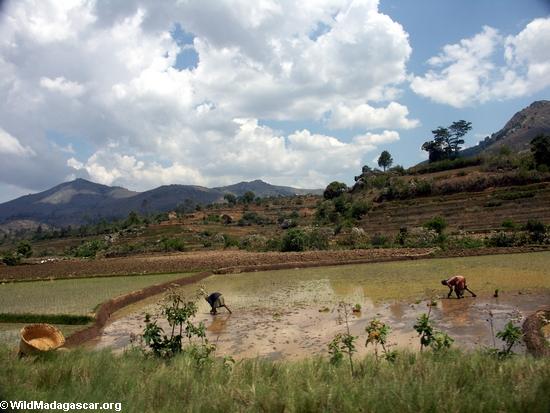Falling price of rice calms street violence in Madagascar — Reuters
Rhettt A. Butler, mongabay.com
May 11, 2005
According to the agriculture minister of Madagascar, the country’s rice output has increased causing prices of the island’s staple food to fall and reducing the risk of further unrest over the rising cost of living.
Last month the capital city of Antananarivo was rocked by protests over rising inflation. Students took to the streets throwing rocks and petrol bombs at police while setting fires. These demonstrations were mild in comparison to last June’s protests where students were joined by army reservists and poor mothers.
The fall in the price of rice is significant because the Malagasy — as the people of Madagascar are known — eat more rice per capital than anyone else in the world. Madagascar consumes almost 2.5 million tons of rice a year but due to environmental degradation can no longer feed its population and relies on imports to make up the shortfall.
Agriculture Minister Harison Randriarimanana told Reuters, “We expect production to increase by at least 13 percent…from last year’s 3.0 million tons to 3.4 million tons … The price will fall but not too much because there is also (general) inflation. I think it will stabilise at 700-800 ariary (37-42 U.S. cents per kilo)” down from 1,500 ariary in 2004.
Background
Madagascar, the world’s fourth largest island at about size the size of Texas or France, is one of the world’s poorest countries. The island has an average per capita income of $260 among its 18 million people and nearly half of its children under five years of age are malnourished. In the past three years the country has nearly experienced a civil war and seen the agricultural based economy hit rock bottom during the political turmoil of the past presidential election.
In March 2005, Madagascar became the first recipient of aid under the new Millennium Challenge Account, a US Aid program that gives grants to countries committed to respecting the rule of law and reducing corruption. The $110 million, four-year aid package was officially signed on April 18, 2005 in Washington, D.C. by Madagascar’s president Marc Ravalomanana.
The aid package comes at a time when things are looking up for Madagascar. The country is home to some of the world’s most approachable and unique wildlife including lemurs, a group of primates endemic to the island; brilliantly colored lizards including geckos and chameleons; tenrecs, spiny hedgehog-like creatures; and the fossa, a carnivorous animal that looks like a cross between a puma and a dog but is closely related to the mongoose. This assemblage of peculiar and unique animals has made Madagascar a top conservation priority for years but due to the country’s poverty, many of these animals are today quite rare and threatened with extinction. It is just this biological diversity that has made Madagascar the setting for a new film to be released by Dreamworks in May 2005.
Dreamworks’ Madagascar is one of the most anticipated films of this spring. The computer-animated film tells the story of four urbanite zoo-dwelling animals who escape from New York and experience culture shock when they arrive in a vastly foreign and decidedly wild Madagascar. The movie features voice performances by Jada Pinkett Smith, Chris Rock, David Schwimmer and Ben Stiller and carries a sizeable marketing budget. According to Dreamworks’ CEO Jeffrey Katzenberg, the film has test screened better than blockbuster hit Shrek, which demolished box office records when it was released in 2001. Shrek 2, the sequel, did even better in 2004.
Madagascar, the country, hopes the film will stimulate its tourist industry in a way similar to Kenya’s after the 1985 film Out of Africa was released. Out of Africa, a popular film starring Meryl Streep and Robert Redford, was filmed in Kenya and brought a massive increase in tourism in the five following years. While Madagascar currently receives few American tourists, the film is expected to dramatically raise the profile of the country and add interest in the burgeoning ecotourism sector.
Other Madagascar articles:
- Collapsing vanilla prices will affect Madagascar
- Madagascar Larger Than Life, New Life for Madagascar’s Tourist Industry?
- New media resource on the wildlife of Madagscar
- The Giant Jumping Rat, another peculiarity from Madagascar
- Madagascar looks toward a brighter economic future with movie, new aid package
- Seeking the world’s strangest primate on a tropical island paradise off Madagascar
- Down a river of blood into a remote canyon in Madagascar: Exploring the Manambolo River
- Environmentalists hope a new film will help lemurs
This article used information from wildmadagascar.org, mongabay.com, and Reuters.








